REVIEW OF THE DUCATI PRO II EVO ELECTRIC SCOOTER
Written by Ed Wiles, Scootered Founder
Introduction
Ducati have been making motorbikes since 1950 and are best known for high performance bikes like the Ducati Monsters; but the Bologna-based company have now ventured into electric scooters under their Urban e-Mobility brand. The Pro II Evo, along with the Pro III, is one of the newer additions to that range (following the Pro I, Pro II and Pro II Plus). But has the Italian company transferred its excellence in motorbike manufacturing to its electric scooters, especially the Pro II Evo scooter? Let's take a closer look.
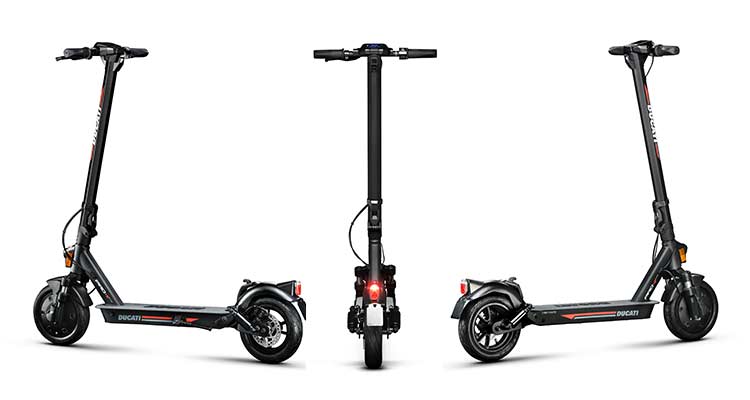
The Basics
The Ducati Pro II Evo is a foldable electric scooter, first released in 2021. The design of the Ducati Pro range is reminiscent of the Xiaomi models and, as the Ducati Pro I was basically a Xiaomi by another name, it seems that they are also manufactured by Ninebot (as with Xiaomi). However, the Pro II Evo and Pro III have obvious and important differences from the Xiaomis (explained in more detail below).
The Ducati Pro II Evo has the usual 25 km/h (16 mph) top speed, a 40 km range, and 15.5 kg weight. The battery is stored in the base (as opposed to the handlebar stem). The dashboard displays more than the normal e-scooter dash and is perhaps more like a motorbike dashboard. It is fairly easy to assemble straight out of the box, and there is a Ducati app to connect to the scooter.
The Design
As with the Lamborghini AL1, the Ducati Pro II Evo uses a magnesium instead of an aluminium alloy, which is one of the ways high-end electric scooters differentiate themselves. The main benefit of using magnesium (to the consumer) is that it is about a third lighter than aluminium; but at about 15.5 kg, the Pro II Evo is still relatively heavy. Magnesium is more expensive than aluminium so it does add extra cost to the scooter. There is also one element (pun intended) to magnesium that is often overlooked; and that is its environmental friendliness. As magnesium can be made from sea water it is considered pretty harmless. Of course, energy is still needed to manufacture it and it also depends on what else is in the alloy. The Pro II Evo has 10 inch tubeless tyres, which is good.
Aesthetics will be down to the individual. Although the first Ducati Pro I used a Xiaomi frame, how the Pro II Evo looks is different in several ways. The most obvious differences are the suspension units at each end, the larger dashboard, the lower headlight, and a smoothed rectangular prism stem instead of a simple cylindrical stem. Then there is of course the Ducati branding.
As mentioned, the display on the Pro II Evo is a cut above the rest and is almost exactly the same (apart from branding) as the significantly more expensive Jeep 2XE Urban Camou dashboard. It is thus perhaps worth spending a little time on. Pictured below, this 3.5 inch LED screen shows: (1) the current speed; (2) the battery level as indicated by the seven bars; (3) total distance traveled; (4) current trip distance; (5) headlight indicator; (6) which of the four modes is being used; (7) cruise control; (8) Bluetooth indicator.
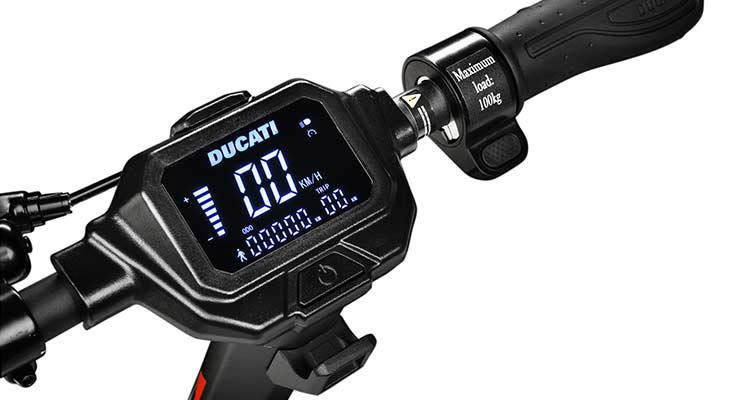
On the left-hand handlebar is a bike-like brake with an in-built bell. The handlebar grips are nicely moulded and Ducati branded. The accelerator is the usual button on the right-hand side (where the "Maximum load" sticker is). The Pro II Evo has a headlight and a rear light (not a brake light). Unusually for e-scooters, the headlight is positioned fairly low on the stem (see below). I'm not sure why different Ducati e-scooters have different headlight positions, or which is better.
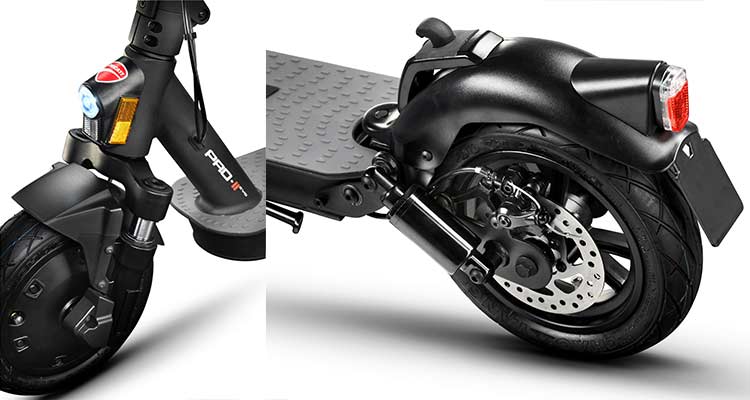
Riding The Ducati Pro II Evo
Ducati have put more thought into making the ride smooth than most manufacturers: not only are the 10 inch tyres pneumatic, but the Pro II Evo has front and rear suspension (seen in image above). It's clear that Ducati's experience in motorbikes was brought to bear here, though e-scooters are of course stood on, meaning the rider provides some of their own suspension (through their knees). Incidentally, Ducati are keen for users to keep their tyres at the right pressure (44 PSI) whereas most brands fail to mention tyre pressure at all.
Ducati have not provided braking distances but the brake is pretty much the same as the Xiaomis (indeed, the disc itself is clearly the same). By the way, if you are not used to riding scooters, the first time you ride any e-scooter will likely be somewhat nerve-wracking.
So please take it easy to begin with. We always recommend wearing a helmet too.
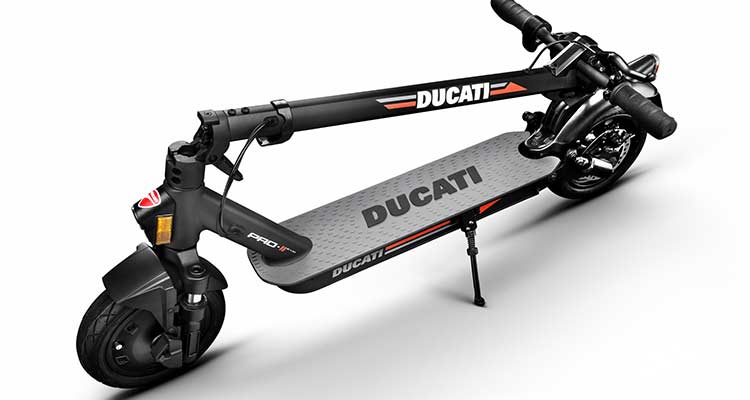
There are four riding modes: (1) the PEDESTRIAN mode limits the speed to 6 km/h; (2) ECO mode limits speed to 15 km/h; (3) COMFORT mode limits speed to 20 km/h; (4) SPORT mode limits the speed to 25 km/h. I am yet to meet anyone who does not use sport mode almost exclusively (as lower speeds can be used/maintained in sport mode by simply not pressing down on the accelerator as much).
The Ducati App
The Ducati Urban e-Mobility app is the same as Lamborghini's AL e-mobility app; and very good in comparison to what mid-range e-scooters like the Xiaomis offer. For instance, you have a useful map feature (like those found in hire scheme apps), which allows you to track your rides as well as locate your e-scooter (should you forget where you left it). The semi-circular speedometer - imitating a motorbike - is a nice touch (though perhaps liable to encourage people to ride as fast as possible regardless of the conditions).
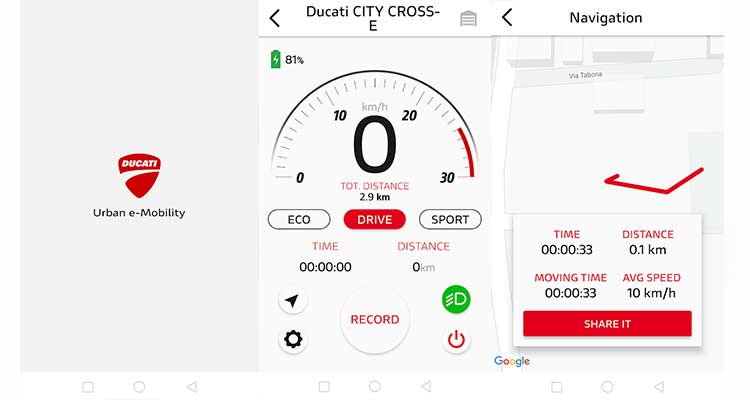
Battery & Motor
The Ducati Pro II comes with a 36 V, 10.4 Ah battery providing 374 Wh, which is pretty good and offers a 40 km range. The rated motor power is 350 Watts, which is also above average. The speed of the e-scooter is, of course, limited artificially (as European governments have generally decided 25 km/h is a safe limit). The extra amps mean the battery is a little bigger and the scooter is a little heavier.
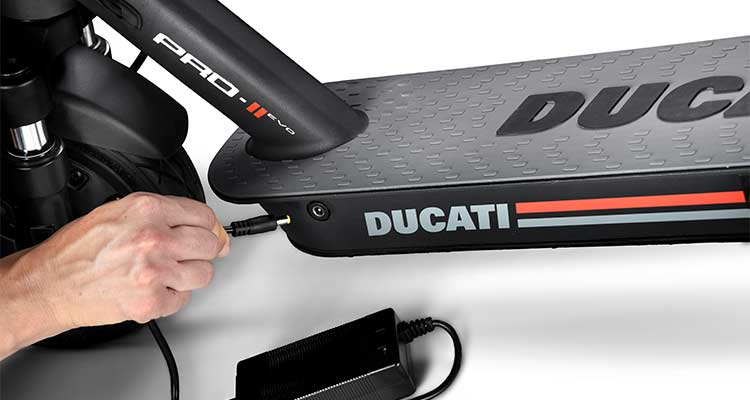
Summary
There's nothing to dislike about the Ducati Pro II Evo. It is more expensive than the Xiaomi Pro 2 and Lamborghini AL1, but has clear advantages over both. Although I am big fan of the AL1, my one caveat has always been the smaller tyres Lamborghini put on its first model; but this is not an issue with the Pro II Evo and its 10 inch tyres (and pressure obsession). Technically speaking, the Pro II Evo is superior to everything Xiaomi and Lamborghini currently offer but you are paying extra for this. So if money is not a concern, it then comes down to the look of the e-scooter, and whether you simply prefer the sleeker curves of the AL1. The Pro II Evo is slightly heavier than near rivals. To conclude, if you can afford it, and don't want to splash out extra on a Pro III, then go for a Pro II.
Rating
Specification Table
| Size (Unfolded) | 116 x 48 x 115 cm |
| Size (Folded) | 116 x 48 x 49 cm |
| Weight | 15.5 kg |
| Output | 350 watts |
| Battery Capacity | 280 Wh |
| Top Speed | 25 km/h |
| Range | 40 km (25 miles) |
| Charge Time | 5/6 hours |
| Tyres | 10 inch air-filled |
| Shock Absorbers | Front & Rear |
| Front Brake | Electronic |
| Rear Brake | Disc (KERS) |
| Waterproof | IPX4: splash resistant |
| Lights | Headlight + Rear Light |
| Riding Modes | Pedestrian/Eco/Comfort/Sport |
| Display | Battery/Speed/Mode/ |

